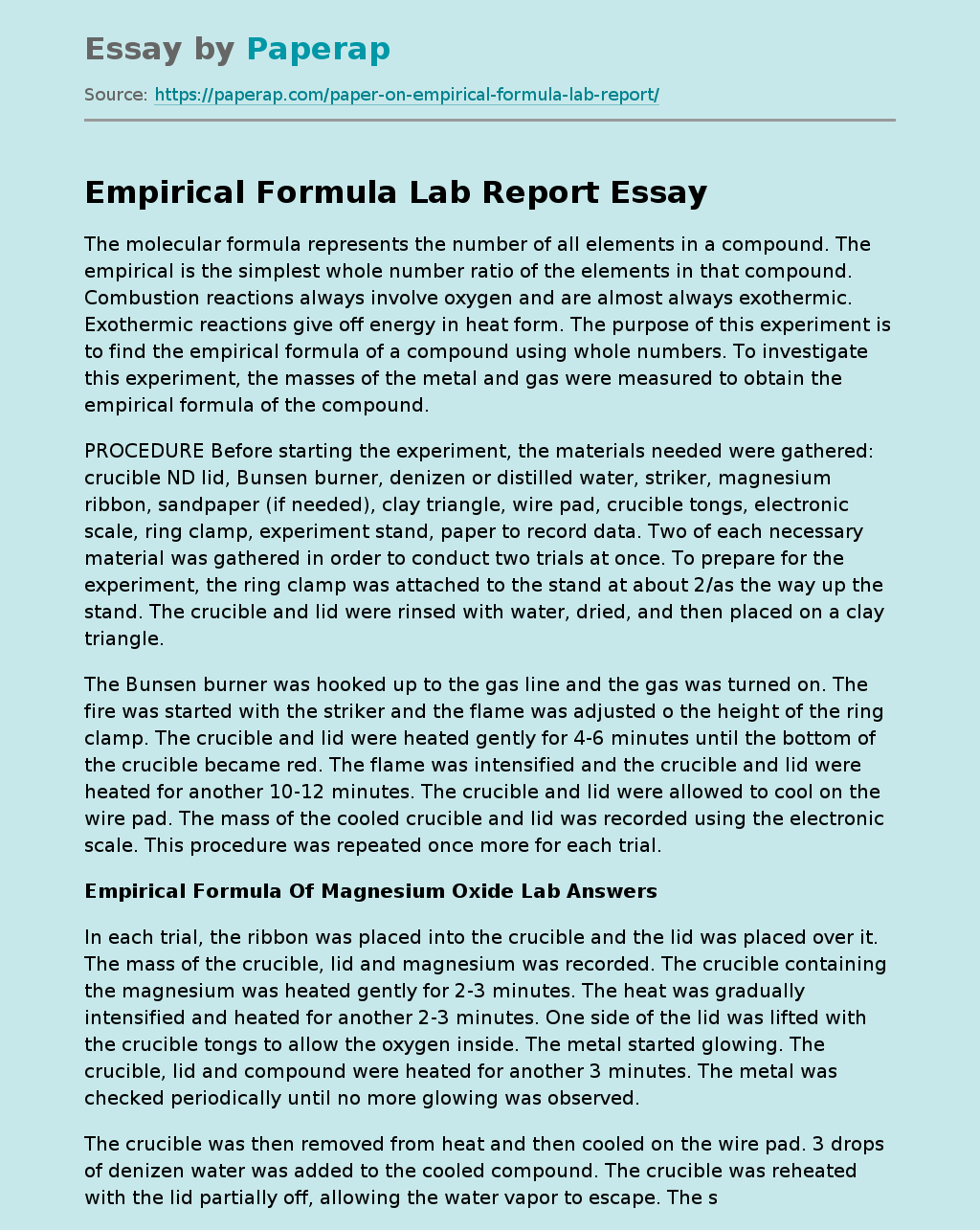Empirical Formula Lab Report
The molecular formula represents the number of all elements in a compound. The empirical is the simplest whole number ratio of the elements in that compound. Combustion reactions always involve oxygen and are almost always exothermic. Exothermic reactions give off energy in heat form. The purpose of this experiment is to find the empirical formula of a compound using whole numbers. To investigate this experiment, the masses of the metal and gas were measured to obtain the empirical formula of the compound.
PROCEDURE Before starting the experiment, the materials needed were gathered: crucible ND lid, Bunsen burner, denizen or distilled water, striker, magnesium ribbon, sandpaper (if needed), clay triangle, wire pad, crucible tongs, electronic scale, ring clamp, experiment stand, paper to record data. Two of each necessary material was gathered in order to conduct two trials at once. To prepare for the experiment, the ring clamp was attached to the stand at about 2/as the way up the stand. The crucible and lid were rinsed with water, dried, and then placed on a clay triangle.
The Bunsen burner was hooked up to the gas line and the gas was turned on. The fire was started with the striker and the flame was adjusted o the height of the ring clamp. The crucible and lid were heated gently for 4-6 minutes until the bottom of the crucible became red. The flame was intensified and the crucible and lid were heated for another 10-12 minutes. The crucible and lid were allowed to cool on the wire pad.
The mass of the cooled crucible and lid was recorded using the electronic scale. This procedure was repeated once more for each trial.
Empirical Formula Of Magnesium Oxide Lab Answers
In each trial, the ribbon was placed into the crucible and the lid was placed over it. The mass of the crucible, lid and magnesium was recorded. The crucible containing the magnesium was heated gently for 2-3 minutes. The heat was gradually intensified and heated for another 2-3 minutes. One side of the lid was lifted with the crucible tongs to allow the oxygen inside. The metal started glowing. The crucible, lid and compound were heated for another 3 minutes. The metal was checked periodically until no more glowing was observed.
The crucible was then removed from heat and then cooled on the wire pad. 3 drops of denizen water was added to the cooled compound. The crucible was reheated with the lid partially off, allowing the water vapor to escape. The sample was heated slowly and then the heat was intensified for 15-17 minutes. The crucible, lid and compound were allowed to cool on the wire pad. The mass of the crucible, lid and compound was recorded. The sample was reheated for an extra 5 minutes, then the combined mass of the crucible, lid and metal oxide was measured.
Some magnesium oxide escaped, when the crucible was not covered. The crucible had to be slightly ajar when heating up the magnesium, so that oxygen could get to the reaction. Without oxygen, a fire cannot exist. The shininess of the metal MGM turned to a dull appearance as it changed to MGM. As the magnesium reacted to the oxygen, it also reacted with the nitrogen in the air to form magnesium nitride, Among. To expel the nitrogen room the crucible, we added water to the mixture and heated it up. This would cause the Among, to react with the water, H2O, to form ammonia, NH, and magnesium hydroxide, MGM(OH)2.
The NH was driven off during the heating. One sign of this reaction was the ammonia smell given off. This is because upon heating, the MGM(OH)2 would break into MGM and H2O, which would be driven off by the heat. The second reheating was so that any remnants of the of the crucible had been converted to MGM. This was also to have an accurate final mass of our product MGM. After the lab, the inside of the crucible was black. This s because the magnesium not only reacted with the oxygen and the nitrogen in the air but also with the porcelain of the crucible.
The reason for waiting for the crucible to cool before weighing it was because at higher temperatures, the molecules inside are still active, causing the weight to be off. During Trial 2, the magnesium was not properly burned off and caused the calculations to be off. The magnesium looked as if it had stopped glowing, but the inside coil was not completely burned.
Empirical Formula Lab Report. (2019, Dec 05). Retrieved from https://paperap.com/paper-on-empirical-formula-lab-report/

